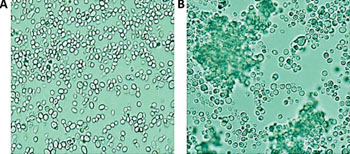Fatal Fungal Infection Has Unique Growth Patterns
By LabMedica International staff writers
Posted on 08 Sep 2016
The multidrug-resistant yeast Candida auris, which has caused fatal infections in some hospitalized patients, has at least two different growth patterns and some of its strains are as capable of causing disease as the most invasive type of yeast called Candida albicans.Posted on 08 Sep 2016
Normally, a yeast copies itself and divides during growth, but the C. auris samples differ in their growth characteristics in the laboratory, with a proportion failing to separate after budding, resulting in the formation of large clumps of cells that could not be physically disrupted.

Image: A microscopic appearance of non-aggregate-forming isolates (A) and aggregate-forming isolates (B) of Candida auris in phosphate buffered saline suspensions (Photo courtesy of Public Health England).
Mycology specialists at the Public Health England Mycology Reference Laboratory (Bristol, UK) characterized 12 C. auris isolates by ribosomal DNA (rDNA) gene sequencing targeting the 28S rRNA or by internal transcribed spacer 1 (ITS1) regions and matrix-assisted laser desorption ionization–time of flight (MALDI-TOF) analysis or by a combination of the two methods.
The scientists compared the pathogenicity, or disease-causing potential, of the C. auris samples taken from patients treated at six National Health Service hospitals in England with samples of other disease-causing Candida species. To do so, they injected young wax moth larvae (called Galleria mellonella, an insect model used to study human infection) with the assorted Candida samples to measure progression of disease. The investigators also found strain-specific differences in the behavior of C. auris, with the clumped strains being less capable of causing disease than the ones that did not clump. The strains that did not clump were as capable of causing disease as another type of Candida called C. albicans, which is currently believed to have the most disease-causing potential in the Candida family.
Elizabeth Johnson, PhD, director of the National Mycology Reference Laboratory and co-author of the study, said, “Despite receiving considerable attention since its first description, little is known concerning the disease-causing potential of this emerging fungal pathogen. We were surprised to find two very different growth forms of C. auris depending on the strain. We were also surprised by the virulence of this species because in most other types of Candida, the ability to cause disease relates to the organism's ability to form hyphae (fine, branching tube-like structures). C. auris is not able to form these hyphae in the laboratory or in the insect infection model, so we would have predicted reduced ability to cause disease.” The study was published on August 18, 2016, in the journal mSphere.
Related Links:
Public Health England Mycology Reference Laboratory














